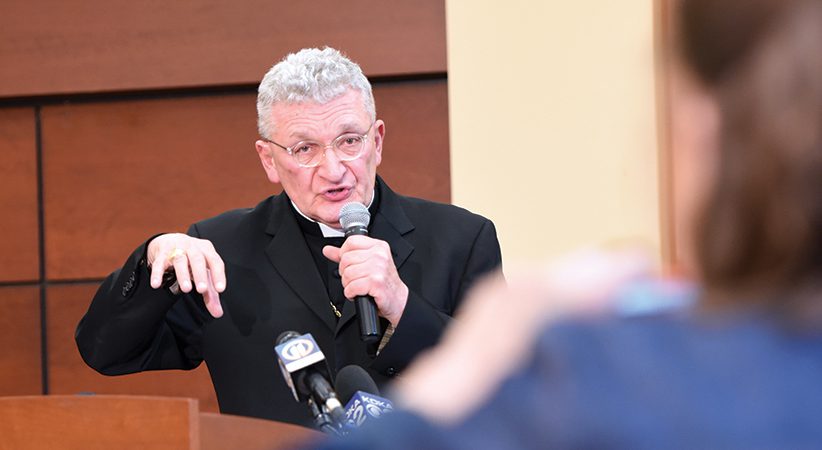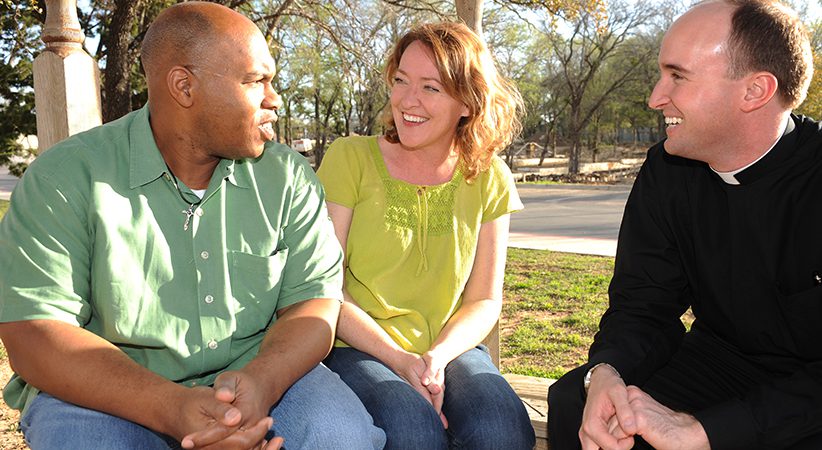Renewing the Priesthood through a Rediscovery of the Diaconate
The exercise of priestly ministry is inescapably diaconal
Deacon Dominic Cerrato Comments Off on Renewing the Priesthood through a Rediscovery of the Diaconate
In a recent address to the transitional deacons of Rome, Pope Francis emphasized how their approaching ordination to the priesthood does not, in any way, diminish their earlier ordination to the diaconate. Concerning this, the pope writes: “One does not become a pastor without first being a deacon. The diaconate does not disappear with priesthood: on the contrary, it is the foundation on which it is based. You will be priests in order to serve, conforming with Jesus who ‘came not to be served but to serve, and to give his life’ (cf Mk 10:45). I would say, then, that there is an inner foundation of priesthood to be preserved, which we could call ‘diaconal conscience’: just as conscience underlies decisions, so the spirit of service underlies being a priest.”
In a soon-to-be-released book on clerical unity (“As I Have Loved You: Clerical Unity in the Heart of Christ,” OSV), I take up this theme suggesting that perhaps the greatest opportunity to renew the priesthood on a personal level is a rediscovery of their diaconate. Where the book provides practical suggestions, these suggestions are grounded in a more integrated theology of holy orders as applied to the presbyterate and episcopate. Unlike the diaconate itself, those who proceed on to the upper grades receive a new ontological configuration and, because these are indelible, the priesthood or episcopacy cohabitates with their earlier diaconate. This cohabitation gives rise to several interesting and rarely explored aspects.
Let’s begin by asking a fundamental question. Why does the Church require that every priest, before he’s ordained to the priesthood, must first be ordained to the diaconate? The historical answer to this question, at least in part, can be found in the adoption of the cursus honorum. This was the Roman practice whereby men advanced progressively from a lower to a higher political office. Concerning the grades of holy orders, the Church adopted this practice in the post-Constantinian era, in both the East and West, to provide sufficient and adequate clerical formation. As a result, a tradition developed where candidates for the priesthood would pass through a series of sequential orders culminating in ordination to the presbyterate over a designated period. It was during this time, beginning in the fourth century, that the diaconate as a “permanent” order slowly declined and became a “transitional” stage to the priesthood.
It’s important to note that despite the introduction of the seminary system by the Council of Trent in the 16th century, which standardized clerical formation, the diaconate remained a “stepping stone” to the presbyterate. Similarly, the practice of ordaining men as transitional deacons continued after the Second Vatican Council restored the diaconate as a permanent order. While some have suggested that this practice is no longer necessary, these suggestions have gone largely overlooked, implying that the Church still sees a certain value, perhaps even an essential value, in ordaining men to the diaconate prior to their ordination to the priesthood.
Mission
To better appreciate this cohabitation of holy orders on a Christological level, we need again consider how, in describing his mission, Jesus defines himself as one who serves and gives himself up for others (cf. Mt 20:28; Mk 10:45). In this one statement, we have both diakonos and sacerdos. Indeed, these descriptors ground his mission into two distinct but interrelated activities and, based on the Latin maxim agere sequitur esse (“to act is to follow being”), says something essential about him. This fundamental truth is used to describe the link between what a person does and who he is, such that what he does flows directly from who he is. Put another way, his actions, especially those of great importance to him, emanate from his sense of identity.
In this respect, Jesus is both diakonos (one who serves), and sacerdos (one who offers sacrifice and is sacrificed). Applied to the Paschal Mystery, in Jesus’ passion, death, resurrection and ascension, he gives himself irreducibly as both deacon and priest. He can give himself no other way because both find their definitive meaning in him. In other words, when Jesus gives himself for the salvation of the world, which is perpetuated in holy orders through the mission of the Church, he does so whole and entire. This is not to suggest that each grade of holy orders receives both diakonos and sacerdos. Where the deacon receives only a portion of Christ’s diakonos, the priest and the bishop, having already received Christ’s diakonos in their diaconate, now receive a portion of Christ’s sacerdos, in a measure proper to their respective orders.
Special Grace
Each grade of orders, by the special grace of the Holy Spirit, configures the ordinand to Christ. This configuration imparts an indelible spiritual character, be it episcopal, presbyteral or diaconal. While this teaching is long established, the magisterium and theological community have yet to describe how these orders cohabitate in the one man. By using the term cohabitating, I mean abiding and interacting with one another such that the higher grade does not obliterate or even diminish the lower grade. This cohabitation is important not only to the lives of bishops and priests but to the mission of the Church as that mission plays out in dioceses and parishes.
If this is true, and I am convinced that it is, then the character received at priestly ordination no more effaces, or diminishes, the character of the diaconate ordination than the character received at episcopal ordination effaces or diminishes the character of priestly ordination. Instead, these grades, along with the character and grace they impart, abide and cohabitate in the one man such that they further strengthen and specify him for mission. At the same time, depending on the openness of the recipient, they provide ongoing opportunities to encounter Christ, grow in holiness and participate in his salvation.
Thus, just as it would be unthinkable for a bishop to abandon or diminish his priestly identity at his episcopal ordination, it is equally unthinkable for a priest to abandon or diminish his diaconal identity at his ordination to the presbyterate. Indeed, if this happens with respect to the diaconate, then priests will fail to see Christ the Servant in their ministry and, since bishops are drawn from that very same presbyterate, they, too, will fail to see this same Christ in the exercise of their episcopal ministry.
Sacramental Support
This cohabitation can be figuratively illustrated as concentric spheres, where the inner, more fundamental sphere offers structural and supportive underpinnings for the larger, outer spheres. This imagery describes how each sacramental character coexists and resides within the same individual, layered in significance and scope (Figure 1). In this case, the most fundamental sphere is that of baptism as it now unites the recipient to Christ and is “the basis of the whole Christian life, the gateway to life in the Spirit … and the door which gives access to the other sacraments” (Catechism of the Catholic Church, No. 1213).
Along with confirmation, these innermost spheres provide the structure and underlying support for the next sacrament that imparts character, the diaconate. Likewise, should the deacon advance to the priesthood, the diaconal sphere now gives structure and underlying support to the priestly sphere. Finally, should the priest advance to the episcopacy, the priestly “sphere” now gives structure and underlying support to the episcopal sphere. In each of these sacramental characters, there exists a necessary reliance and interdependence such that, to diminish or ignore an earlier character is to significantly undermine those that were received later.
Bear in mind that, what is considered here, are only the sacraments that impart character. The other four sacraments (Eucharist, reconciliation, anointing of the sick and matrimony) also confer different types of grace. Their absence in this analysis is in no way to diminish their necessary significance. It’s only to underscore how the sacraments of character cohabitate in the one man.
The image of the spheres gives rise to another related observation, that of rediscovery and appropriation. As illustrated above, if a man, after baptism and confirmation, were to pursue ordination of the diaconate, and if he has not progressed in his lay vocation by virtue of those earlier sacraments, then the underlying structure and support for the diaconate is insufficient for fully living out his diaconate. Put another way, the frail structure of the underlying sacraments of baptism and confirmation lack the necessary integrity to support the diaconate. This, in turn, results in a weak deacon. The same is true with the priesthood and episcopacy.
The good news is that, despite an insufficient structure and support of the earlier sacraments, through grace and human effort they can be rediscovered and refortified such that what was once insufficient now becomes sufficient. This is to say that the grace of the earlier sacraments that were received ex opera operato now can be appropriated more fully ex opera operantis. This means that the earlier grace given in potentia now becomes actualized in the person, enabling him to incarnate Christ through his vocation more effectively. With regard to the episcopacy and priesthood, this means an intentional and ongoing appropriation of their diaconate such that it infuses their ministry with Christ the Servant.
First a Deacon
With the above in mind, and returning to the question of why the Church requires that a man must first be a deacon before he becomes a priest, I believe the answer lies in Christ’s own self-identification as deacon and priest (cf. Mk 10:45). Based on Our Lord’s example, as foreshadowed in Isaiah’s Suffering Servant, service is essential to sacrifice, or, to use more ecclesial language, the diaconate is essential to the priesthood.
To better demonstrate what I mean here, consider that the Greek word diakonia (literally meaning “service”), is translated into the Latin term ministerium, which itself is translated into the English term “ministry.” When we speak of “episcopal ministry,” we’re saying the diakonia of the bishop. Likewise, when we speak of “presbyteral ministry,” we’re saying the diakonia of the priest. So, for example, the confection of the Eucharist, which is proper to the priesthood alone, is absolutely dependent upon the exercise of a particular service. Indeed, this potestas sacra remains completely hidden within the priest without its outward manifestation through a sacramental act, an act of diakonia. Thus the exercise of priestly ministry, while exclusive to the priesthood and episcopacy, is inescapably diaconal. The diaconal dimension is, in this way, necessary, but not sufficient. This means that, while sacerdotal ministry is diaconal, diaconal ministry is not sacerdotal, at least not in the same sense.
In his address to the transitional deacons of Rome, quoted at the outset of this analysis, Pope Francis emphasizes the enduring significance of the diaconate within the priesthood, underscoring that being a priest is fundamentally about serving, inspired by Jesus’ example of service and self-sacrifice. He introduces the concept of a “diaconal conscience” as the bedrock of the priesthood, advocating for a daily commitment to service.
Service, according to the pope, is practical and requires readiness for unexpected demands and a departure from personal agendas. He portrays pastoral life as a dynamic and Eucharistic adventure, emphasizing actions over words and a ministry rooted in acceptance, compassion and humility. Because of this, one way in which to renew the priesthood on a personal level is for the priest to rediscover his diaconate — that is, to say, Christ the Servant — within his priestly ministry.
DEACON DOMINIC CERRATO, Ph.D., is editor of The Deacon and director of diaconal formation for the Diocese of Joliet, in Illinois. He is the founder of Diaconal Ministries, where he gives national presentations and retreats to deacons and diaconal candidates.





